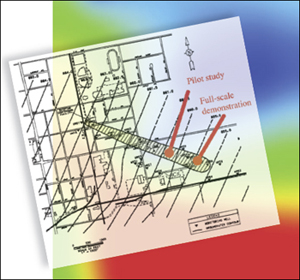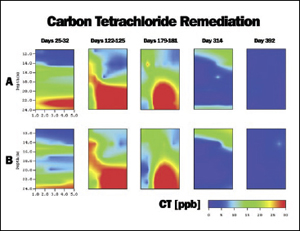Hazardous Waste Remediation: The Schoolcraft Project
- Michael J. Dybas
- Center for Microbial Ecology
- College of Natural Science

Details of a map of the St. Joseph Aquifer below Schoolcraft, Michigan. The oblong shape represents a plume of carbon tetrachloride contamination.
Carbon tetrachloride is a highly toxic substance. If Michigan's Department of Environmental Quality (MDEQ) identifies a concentration of five parts per billion in a water source, it condemns the water as unsafe to drink and requires the responsible party to remediate the problem.
Forty years ago, about 15-25 gallons of carbon tetrachloride were dumped into the St. Joseph Aquifer below Schoolcraft, Michigan. By the early 1990s a toxic plume (or leakage pattern) had penetrated a mile long, a tenth of a mile wide, and 80 feet deep into the aquifer. The plume had begun to threaten lakes and drinking water sources in the direction of the aquifer's flow.
The conventional method of detoxifying the site would have involved using large volumes of air or activated charcoal filters to strip out the carbon tetrachloride—at a cost of five to six million dollars and more than 25 years of work. This air-stripping process is inefficient as well as expensive. It merely transfers some of the pollutants to the atmosphere and produces another pollutant, chloroform, as a byproduct.
Researchers Craig Criddle (Stanford University), Mike Dybas (MSU), and their team of engineers, geologists, and microbiologists had a better idea. In 1988 Craig Criddle, who was then a graduate student and is now an associate professor of environmental engineering at Stanford University, discovered a microbe (P. stutzeri KC) that could transform carbon tetrachloride into carbon dioxide and other inert compounds without producing chloroform. As he later recalled, "We had some old aquifer material sitting in a bucket at the back of a cooler...I set up an enrichment [growing medium] for it...Within two days a surprising thing occurred...Pearly white balls formed, and there was no detectable carbon tetrachloride. Best of all, there was no detectable chloroform. At the time I didn't think we had isolated anything unique."

Charting progress: Reds/yellows indicate a presence of carbon tetrachloride. After 392 days it has all but disappeared.
Dr. Criddle was still exploring the idiosyncrasies of his microbe when he visited Michigan State University in 1991. The MSU group discovered that P. stutzeri KC's precise growing requirements could easily be achieved by adjusting the pH of the medium—a finding that Dr. Michael Dybas, the current project investigator, referred to as "the heart of the technology."
A graduate student who had been a hydrogeologist on the Schoolcraft plume cleanup told Criddle about the project. Working with the Schoolcraft community and MSU Extension, Criddle's team successfully tested their bacterium on a groundwater and sediment mix from the St. Joseph aquifer.
The question then became, would the microbe be able to colonize itself onsite? First, the physical, geological, chemical, and other characteristics of the aquifer were studied. Next, modeling and cost analysis confirmed that a biocurtain (system of closely spaced wells) to span the plume and deliver the P. stutzeri KC solution, was technically feasible and economical. A pilot biocurtain system was then designed and constructed—delivery and monitoring wells were built, tracers were used to record the flow of materials inoculated into the groundwater, and the culture was adjusted as its performance was monitored.
P. stutzeri KC proved to be a highly cost-effective, ecologically sustainable solution that shows promise for generalizing to other situations. With funding from MDEQ, the team is currently addressing other, larger and more complex plumes in the aquifer.
- Written by Linda Chapel Jackson, University Outreach and Engagement